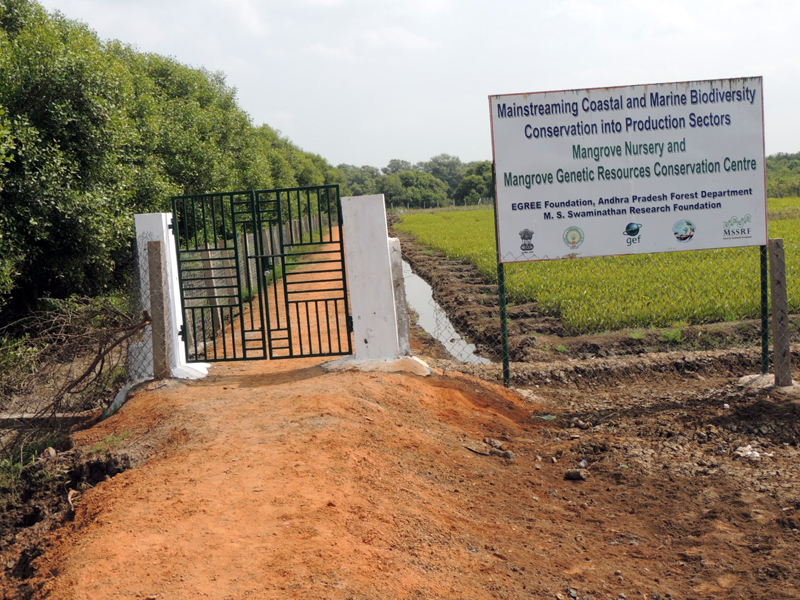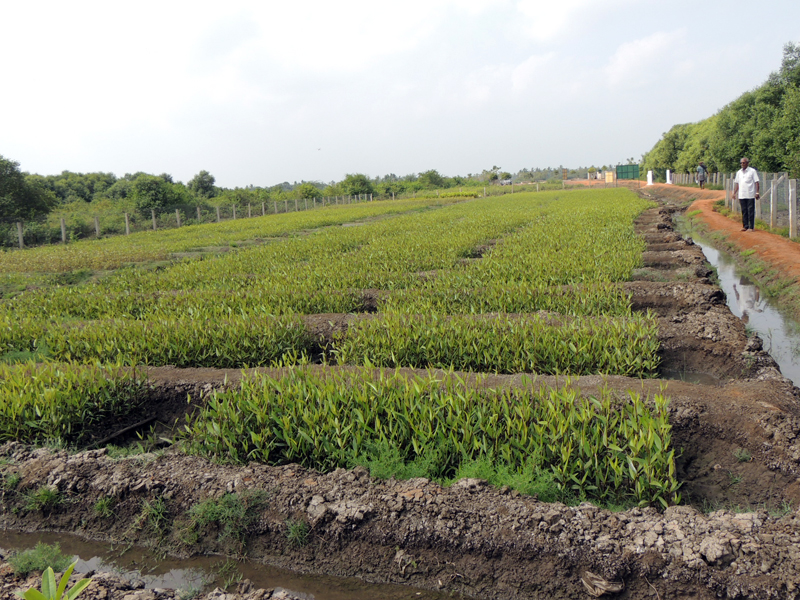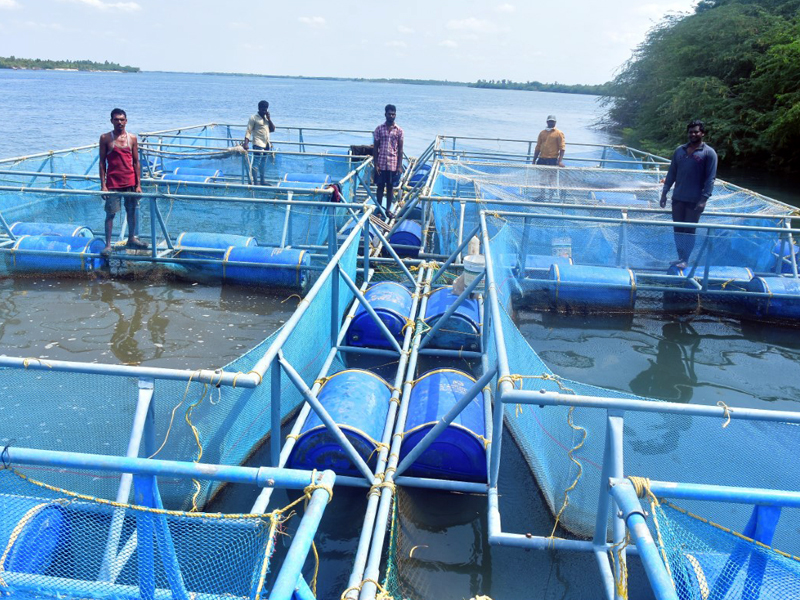Mangrove conservation and management activities continued in the states of Tamil Nadu, Andhra Pradesh and Maharashtra. Mangrove Genetic Resources Conservation Centre (MGRCC) was established in the Coringa Wildlife Sanctuary with 25 mangrove species collected from different parts of the country. Propagation of Scyphiphora hydrophyllacea Gaertn., a rare and endemic species in the Godavari mangrove wetland, was done through air layering as propagation through seeds failed. During the launch of YSR Matsyakara Bharosa, on the occasion of the World Fisheries Day (21 November 2019), at Komanapalli in Mummidivaramin, East Godavari district, Mr. Jagan Mohan Reddy, the Hon’ble Chief Minister of Andhra Pradesh, was briefed about the activities of mangrove conservation and management as well as Fisher Friend Mobile Application (FFMA) in Andhra Pradesh.
101.1 Mangrove Restoration
Thiruvalluvar District, Tamil Nadu: Desilting and casualty replacement work was completed in the mangrove plantation established in an area of 15 ha in the Koratallaiyar River estuary, Ennore, near the NTPC Tamil Nadu Energy Company Ltd (NTECL) power plant (80°18’43.75″E, 13°13’34.86″N). The rate of survival of the planted mangrove saplings was about 80 per cent; apart from the planted saplings, more than 40000 seedlings of Avicennia marina were established naturally. About 10000 matured seeds of Avicennia spp. and 5000 propagules of Rhizophora spp. were planted in October 2019 to replace the casualties due to increase in soil salinity in summer.
Krishna District, Andhra Pradesh: Desilting of canals in the 200 ha mangrove plantation established in Basavanipalem village of Ramakrishnapuram panchayat, Koduru mandal, in the Sorlagondi Extension Reserve Forest was completed in July 2019. About 40000 Rhizophora apiculata and 10000 R. mucronata propagules were planted to replace the casualty of the saplings during October 2019. The average height of the Rhizophora saplings is about 80 cm. A midterm evaluation of the project on conservation and management of coastal resources as a potential adaptation strategy for sea-level rise underway here was commissioned by NABARD and conducted by Prof. Saudamini Das, NABARD Chair Professor, Institute of Economic Growth, New Delhi, from 8 to 11 September 2019 employing tools such as focus group discussions and socioeconomic questionnaire survey to assess the impact of the project. German Watch, Germany, which co-ordinates the Adaptation Fund NGO Network (AFN), has given the task of independent evaluation to Development Alternatives (DA), New Delhi, one of the network’s core partners. The team from DA carried out evaluation activities between 30 September and 2 October 2019 through field visits and interaction with the stakeholders, and the outcomes were presented in the side event organized at COP25 in Madrid, Spain, on 11 December 2019.


101.2 Integrated Mangrove Fishery Farming System
Integrated Mangrove Fishery Farming System (IMFFS) farms have been developed in an area of 25 ha during this year. Six farmers initiated stocking of shrimp, and other farmers are now ready to stock fishes/crabs. About 9000 mangrove saplings were planted along the inner bunds in the intertidal area. Farmers associated with IMFFS have been culturing shrimp, crab and sea bass in these farms.


Mr D. Nalini Mohan, IFS, Principal Chief Conservator of Forests (PCCF) and Chief Wildlife Warden, Andhra Pradesh Forest Department, and Mr N. Nageswara Rao, IFS, Conservator of the Forests, Rajahmundry, monitored the mangrove restored site on 25 January 2020. In his feedback, the PCCF stated that the survival rate of the planted saplings was good. He also observed that Avicennia sp. was establishing naturally in the restored site in large numbers, which indicates that the site will have a good canopy cover in due course.
East Godavari District: Mangrove Genetic Resources Conservation Centre (MGRCC) was established in the Coringa Wildlife Sanctuary, East Godavari district, Andhra Pradesh, with 25 mangrove species collected from the eastern and western coasts of India. In July 2019, Nypa fruticans, Xylocarpus mekongensis, Aegialitis rotundifolia and Heritiera fomes were collected from the Sunderbans, West Bengal, and Bruguiera sexangula, Kandelia candel, Aglaia cucullata, Cerbera odollam and Cynometra ramiflora were collected from the Mahanadi delta, Odisha. Ceriops tagal propagules were collected from Ratnagiri mangroves, Maharashtra, and Rhizophora mucronata from Tamil Nadu in September 2019. The remaining 14 species were taken from the Krishna and Godavari mangrove wetlands (including S. hydrophyllacea propagated through air layering). These were planted in the MGRCC between July and September 2019.
Vegetative Propagation of S. Hydrophyllacea Gaertn: Only few plants of S. hydrophyllacea, a rare and endemic species, are found near the Sacramento lighthouse in Kothapalem Reserve Forest (RF) in the Godavari mangrove wetland; attempts at propagation through seeds, stem cuttings and micropropagation techniques having failed and therefore air layering was attempted. About 100 semi-hard straight wooden branches were selected for air layering during May 2019. The bark of the selected branch was removed partially (about 70 percent) to a length of about 2 cm below the node leaving about 30 percent of the bark intact for performing physiological functions since root formation takes at least 2–3 months. Karadix, a commercially available hormone promoting root growth, was used to initiate root formation. The hormone powder was applied all over the wounded portion of the branch using a fine brush. Wet mangrove soil and coconut fibers were used as the rooting medium. A thick polythene layer was wrapped tightly around the medium to retain moisture. Intermittent moistening (once in 20 days) was done to keep the rooting medium wet to enable root. Roots appeared after 3 months of layering. Once sufficient roots were formed, about 23 young plants (23 percent success rate) were removed from the mother plants on 3 October 2019 (after 4 months) and planted in polythene bags containing mangrove soil. The saplings were kept in shade for another 20 days and regular watering was done with less saline water. Thereafter, they were transferred to the mangrove nursery and grown for another 2 months before being planted in the MGRCC.
Training and Capacity Building: Training on mangrove sylviculture practices was imparted to members of Vana Samrakshna Samithi (VSS) and Eco-Development Committee (EDC) in the Godavari mangrove area and the field staff of the forest department of Krishna and Godavari wetlands on 5 October 2019 at the office of the Chief Conservator of Forests, Rajahmundry. A total of 60 members participated in the interactive session. Mangrove sylviculture-related topics, such as the establishment of nurseries having multiple species, fruiting season and identification of matured propagules, identification of suitable areas for nursery and mangrove restoration, restoration of degraded mangroves and vegetative propagation of mangroves, were explained.
Navi Mumbai, Maharashtra: Mangrove restoration work was completed in 3 ha of the degraded area identified near Mandala, Mumbai, located close to Thane Creek and the Sion–Panvel Expressway. This area, on which the local community had encroached, was evacuated by the forest department and permission given to restore it in June 2019. Canal digging work was initiated on 29 August and completed on 14 September 2019. About 300 m of main canal and 2150 m of side canals were dug and 3000 matured A. marina seeds and 2000 matured propagules of Ceriops tagal were planted in October 2019.
101.3 Cage Culture
A pilot on cage culture of sea bass was initiated to enhance the adaptive capacity of the local community to sea-level rise. Six floating cages were fabricated using galvanized iron pipes. The cages had inner frames measuring 5 x 5 m and outer frames measuring 6 x 6 m and were fixed so that they floated on eight high-density polyethylene (HDPE) barrels having a capacity of 200 litres each. HDPE braided inner nets (5 x 5 x 3 m with mesh size of 25 mm) and outer nets (6 x 6 x 4 m with mesh size of 40 mm) were used as enclosures for culturing sea bass. Bird nets (80 mm) were placed on top to prevent entry of birds, especially little cormorants. In each cage, about 1000 Asian sea bass (Lates calcarifer) fingerlings procured from the Rajiv Gandhi Center for Aquaculture, Thoduvai, near Sirkazhi, Nagapattinam district, Tamil Nadu, were stocked on 11 January 2020. As the fingerlings were very small (5 mm wide and 20 mm long), they were reared inside the cage with a net having a mesh size of 2 mm enclosure (hapa) till 3 months. Regular feeding, based on body weight, was provided using fish meal prepared by grinding low-cost trash fishes. The nets were cleaned regularly to allow unobstructed water flow, especially in the small mesh size enclosures. The fingerlings were transferred into the inner net of the cage after 3 months by which time the fishes weighed 50 g. Feeding was done twice a day. Now the sea bass fishes have attained sizes ranging from 13 to 19 cm with weights ranging from 76 to 110 g. The survival rate stands at 68–80 per cent.


101.4 Integrated Rural Development Programme
In the Integrated Rural Development Programme, a coastal village resource centre to cater the needs of the coastal community has been established in Machilipatnam, Andhra Pradesh with the support of Mitsubishi Corporation, Japan. Recently, the government high school at Mangalapuram started a digital classroom facility and 50 chairs and 4 tables were provided for the smart classroom. In the primary school at North SC colony of Mangalapuram, a toilet (3.5 x 3.5 x 2.5 m) and a compound wall with gate (length 33 m and height 2 m) were constructed.
In Muthurasupalem hamlet of Mangalapuram, a bore well was dug and connected to the pipeline that supplies drinking water to the entire hamlet, and a pump house with electrical motor was also constructed. In the summer months, Sorlagondi and Mangalapuram villages usually face water scarcity; there have also been outbreaks of waterborne diseases. Bore wells were dug in both these villages; however, in Sorlagondi, the total dissolved solids (TDS) found in the bore water was 1500 mg/L, and in Mangalapuram, it was about 250 mg/L, which made the water unfit for human consumption. Therefore, reverse osmosis (RO) plants were installed in these villages. The TDS of the treated water from the RO plants is between 15 and 20 mg/L, without any microbial contamination. The local community is managing these plants and charges a nominal user fee of Rs 5/20 L of water to maintain the plants. Two bus shelters were also constructed in Mangalapuram village, and the local community, particularly women and school children, find them very useful.
In Mangalapuram, poor agricultural laborers living in the scheduled caste (SC) and backward class (BC) colonies requested permission to construct community halls in their respective hamlets for conducting community meetings, festivals, and wedding ceremonies. The villagers provided the land for this. In South SC Colony, a multipurpose community hall measuring 12 x 12 feet and having a concrete roof with a GI sheet roof shed measuring 12 x 36 feet was constructed. Another community hall is being constructed in Muthurasupalem, the BC colony. In North SC Colony, a dilapidated multipurpose building with no doors, windows, or compound wall, which served as a library earlier, was renovated and electricity connection provided. A table and 15 chairs were also provided for self-help group (SHG) meetings. Now the local community is using the building effectively.
101.5 Greenhouse Gas Fluxes in the Mangrove Ecosystem
Globally, atmospheric greenhouse gases (GHGs) have been increasing in recent years due to natural and anthropogenic causes. This study in the Pichavaram mangrove ecosystem is part of a collaborative project with Indian Institute of Tropical Meteorology, Pune, under the MetFlux India project of the Ministry of Earth Sciences (MoES), to ascertain whether the mangrove wetland acts as sink or source of GHGs. An eddy covariance (EC) tower established in 2015 measures the GHG fluxes. Parameters such as atmospheric temperature, relative humidity, wind speed, wind direction, precipitation, photosynthetic active radiation and net solar radiation are measured continuously and pCO2 and air-water CO2 flux and methane flux data collected. The study results show that the Pichavaram mangroves act as a sink for CO2 for most part of the year. Methane emission is also fairly low in the Pichavaram mangroves with slightly higher emission in the wet season.
